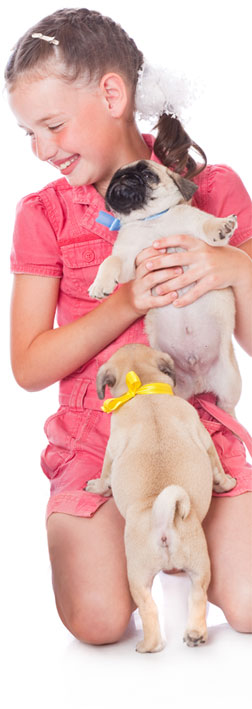If you see this icon in a fact sheet summary you may be dealing with a life threatening issue. Consult a veterinarian immediately.
Use our webform to ask a question or book an appointment

GASTROENTERITIS
Gastroenteritis is an inflammation of the stomach and intestinal tract, presenting as vomiting and/or diarrhoea. Potential causes are many and varied, with the main culprits being intestinal worms, bacterial or viral infections, or eating something that upsets the gut such as ‘garbage,’ cooked bones and excessively fatty meals.
While most episodes of gastroenteritis do not turn out to be serious, regular worming, vaccination and care with your pet’s diet will greatly reduce the chance of it reoccurring.
SEVERITY: Generally minor. Treatable. NB: Rare cases of the more severe Paroviral enteritis require ICU hospital treatment.
Clinical signs are usually obvious, presenting as abnormal episodes of vomiting and/or diarrhoea. Other than vomiting the dog will usually be perfectly happy and normal. Owners will also often be aware that their pet has eaten something they shouldn’t. You may also see signs of lethargy.
Diagnosis is usually straightforward at a visual examination/consult. Patients suffering gastroenteritis will often still be quite bright and happy. If they present with lethargy/depression as well as vomiting/diarrhoea, other more serious conditions may be present and blood tests and/or other diagnostic tests may be needed.
The exception is parvoviral enteritis. Parvovirus causes a potentially very severe, and possibly fatal, form of enteritis in dogs, which requires the patient to be hospitalised under intensive care conditions, often for a week or more.
Treatment involves first ruling out worms as a cause. This is done by knowing the patient has recently been wormed with an effective dose of an effective drug, or by worming them at the time. Then we give the stomach and intestines a rest. The most common problem we see is that patients have been fed too much too soon after the signs started, which triggers another bout of vomiting or diarrhoea.
In most cases the best course of action is to feed nothing for 24 hours (allowing free access to water) and then introduce regular, small, bland meals. ‘Bland’ means food that is not rich enough to upset the gut and is easily digested. Suitable foods may be boiled chicken — no skin, no fat, no bones — and boiled white rice, or one of the commercially prepared prescription diets available from the hospital. Small meals ensure the volume of food will not over stretch the gut and cause further irritation.
Once the initial vomiting/diarrhoea has stopped meals are gradually increased in size and the frequency reduced, then normal food is added little by little over a period of a week. See the ‘Diet’ tab for an example of an effective recovery diet.
Many patients will get better if they revert to normal feeding earlier than this but some will return to vomiting/diarrhoea. You cannot know which ones will relapse until it happens so it’s best to treat all patients as if they will be one of the more sensitive ones. If at any time the vomiting or diarrhoea recurs it is very important to let us know so we can reassess the diagnosis and treatment.
An injection may be given to settle the nausea/vomiting and sometimes a course of antibiotics will be prescribed if bacterial infection is suspected. Antibiotics are often held in reserve as most patients improve rapidly without them.
This is an example of a daily recovery feeding regime pet carers can use and which we have found very effective. In our experience the most common cause of a recurrence of gastroenteritis is owners not following this regime precisely and either feeding too much or reverting to a normal meal size before the seven days are up.
Day 1.
Water only.
Day 2.
Food: Veterinary Diet, canned or dry.
Frequency: 4-6 times per day
Amount: one-eighth of normal meal size
Day 3.
Food: Veterinary Diet, canned or dry
Frequency: 3-4 times per day
Amount: one-quarter normal meal size
Day 4.
Food: three-quarters Veterinary Diet, plus one-quarter normal food (mixed together)
Frequency: 3-4 times per day
Amount: one-quarter normal meal size
Day 5.
Half Veterinary Diet, plus half normal food (mixed together)
Frequency: 2-3 times per day
Amount: one-third normal meal size
Day 6.
Food: Veterinary Diet, plus three-quarters normal food (mixed together)
Frequency: twice a day
Amount: half normal meal size
Day 7.
Feed normally
MORE DISEASES OF DOGS
DOGS: ADVICE FOR EMERGENCIES


